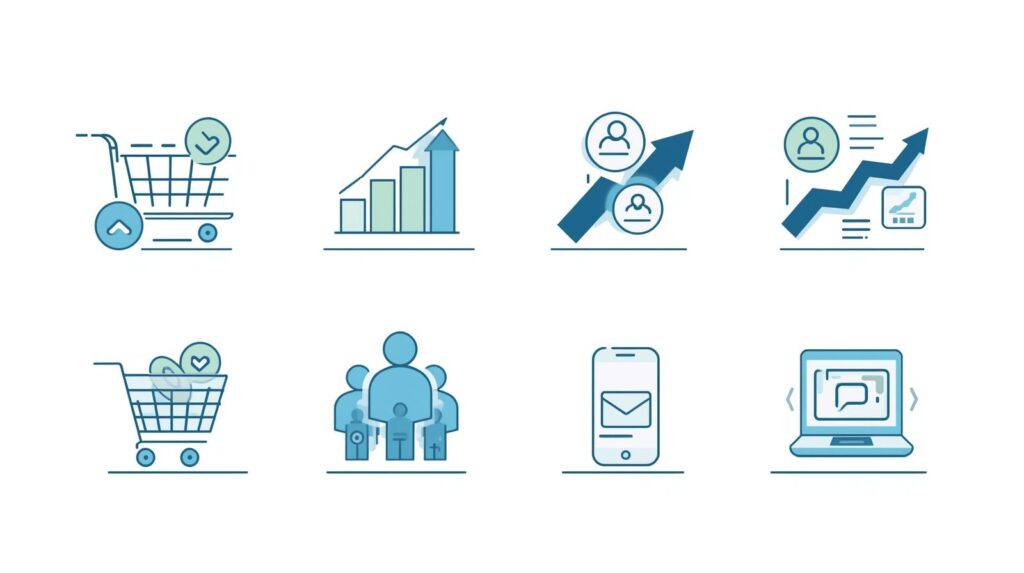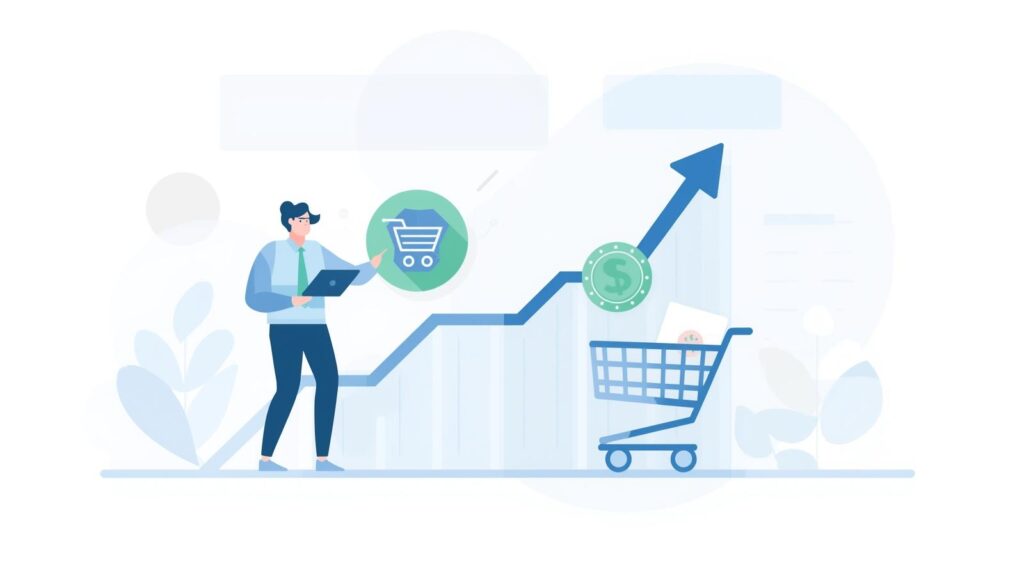Table of Contents
Transform Your Online Store with Proven Growth Tactics
Ecommerce Growth Strategies can make or break your online business in today’s competitive digital marketplace. With millions of online stores fighting for customer attention, having a solid growth plan isn’t optional anymore – it’s essential for survival. Whether you’re just starting out or looking to scale an established business, the right strategies can dramatically increase your revenue and customer base.
The good news? You don’t need a massive budget or a team of marketing experts to grow your ecommerce business. What you need is a clear understanding of what works, the discipline to implement these strategies consistently, and the patience to let them compound over time. In this guide, we’ll walk through eight practical Ecommerce Growth Strategies that you can start applying to your business today.
Let’s cut through the noise and focus on what actually moves the needle. These aren’t theoretical concepts – they’re battle-tested tactics that successful online stores use every day to increase sales, improve customer loyalty, and build sustainable growth.

Strategy 1: Optimize Your Conversion Rate
Before you spend another dollar driving traffic to your site, make sure you’re converting the visitors you already have. This is one of the most cost-effective Ecommerce Growth Strategies because you’re maximizing the value of your existing traffic.
Start with Your Product Pages
Your product pages are where the magic happens – or doesn’t. Here’s what you need to nail down:
- High-quality images: Show your products from multiple angles with zoom functionality. People can’t touch your products, so images need to do the heavy lifting
- Compelling descriptions: Don’t just list features – explain benefits. How will this product improve your customer’s life?
- Social proof: Display customer reviews prominently. According to Shopify’s conversion research, product pages with reviews see significantly higher conversion rates
- Clear calls-to-action: Make your “Add to Cart” button impossible to miss
- Trust signals: Security badges, return policies, and guarantees reduce purchase anxiety
Streamline Your Checkout Process
Every extra step in your checkout is an opportunity for customers to abandon their carts. Keep it simple – ask only for essential information, offer guest checkout, and provide multiple payment options including digital wallets like Apple Pay and PayPal.
Strategy 2: Build and Nurture Your Email List
Email marketing remains one of the highest ROI channels for ecommerce businesses. It’s a direct line to your customers that you own – unlike social media followers who can disappear when algorithms change.
Capture Emails Strategically
Don’t just slap a generic “Subscribe to our newsletter” popup on your site and hope for the best. Offer real value in exchange for email addresses:
- First purchase discounts: 10-15% off in exchange for signing up works consistently
- Exclusive content: Buying guides, styling tips, or insider information relevant to your products
- Early access: Let subscribers shop new collections or sales before the general public
- Free resources: Downloadable guides, templates, or tools that solve problems for your audience
Segment and Personalize Your Campaigns
Sending the same email to your entire list is lazy and ineffective. These Ecommerce Growth Strategies require segmentation based on purchase history, browsing behavior, and engagement levels. A first-time buyer needs different messaging than a loyal customer who’s made five purchases.
Strategy 3: Leverage Social Commerce
Social media isn’t just for building brand awareness anymore – it’s a full-fledged sales channel. With features like Instagram Shopping and Facebook Marketplace, you can meet customers where they’re already spending their time.
Make Your Products Shoppable
Tag products in your Instagram posts and Stories so customers can purchase without leaving the app. The fewer steps between discovery and purchase, the higher your conversion rate. Create content that feels native to each platform – polished lifestyle shots for Instagram, quick product demos for TikTok, community-building content for Facebook.
Use User-Generated Content
Nothing sells better than seeing real customers enjoying your products. Encourage customers to share photos of their purchases by creating a branded hashtag, running contests, or offering incentives. Then feature this content on your social channels and product pages. It’s authentic, free marketing that builds trust.
Strategy 4: Implement a Customer Retention Program
Acquiring new customers costs five to seven times more than retaining existing ones. Yet most ecommerce businesses obsess over acquisition while neglecting retention. Smart Ecommerce Growth Strategies prioritize keeping customers coming back.
Create a Loyalty Program That Works
Loyalty programs shouldn’t be complicated. Points for purchases, rewards for referrals, and exclusive perks for top customers – keep it simple and valuable. As Forbes points out in their retention guide, increasing customer retention rates by just 5% can increase profits by 25% to 95%.
Master Post-Purchase Communication
The conversation shouldn’t end when the sale is made. Send order confirmations, shipping updates, and delivery notifications. Follow up with care instructions, usage tips, or complementary product recommendations. Ask for reviews. Check in to ensure satisfaction. These touchpoints strengthen relationships and increase the likelihood of repeat purchases.
Strategy 5: Invest in Content Marketing
Content marketing is the long game, but it pays dividends. By creating valuable content that attracts and educates your target audience, you’re building organic traffic that doesn’t disappear when you stop paying for ads.
Blog with Purpose
Don’t just churn out generic blog posts. Create content that solves real problems your customers face. If you sell fitness equipment, write detailed guides about home workout routines, proper form, or nutrition tips. Answer the questions your customers are actually asking.
Diversify Your Content Formats
Not everyone prefers reading blog posts. Create video tutorials, infographics, podcasts, or downloadable guides. Different formats reach different segments of your audience and give you more content to share across multiple channels.
Strategy 6: Optimize for Mobile Commerce
Mobile commerce accounts for over 70% of ecommerce traffic globally. If your site isn’t optimized for mobile, you’re literally turning away the majority of potential customers. This is non-negotiable among modern Ecommerce Growth Strategies.

Mobile-First Design Principles
- Fast loading speeds: Mobile users are impatient. Compress images, minimize code, use fast hosting
- Thumb-friendly navigation: Make buttons and links large enough to tap easily
- Simplified forms: Minimize typing with autofill, dropdown menus, and smart defaults
- Mobile payment options: Integrate Apple Pay, Google Pay, and one-click checkout options
- Responsive images: Ensure product photos look great and load quickly on smaller screens
Test on Real Devices
Don’t just resize your browser window and call it mobile testing. Actually test your site on various phones and tablets. What looks great on your computer might be a frustrating mess on a phone with a slow connection.
Measuring Success and Continuous Improvement
The most important of all Ecommerce Growth Strategies is measuring what matters and constantly optimizing. You can’t improve what you don’t measure.
Key Metrics to Track
- Conversion rate: Percentage of visitors who make a purchase
- Average order value: How much customers spend per transaction
- Customer lifetime value: Total revenue from a customer over their entire relationship with your brand
- Cart abandonment rate: How many shoppers add items but don’t complete checkout
- Return customer rate: Percentage of customers who purchase more than once
- Email engagement rates: Opens, clicks, and conversions from email campaigns
Use A/B Testing
Don’t guess what works – test it. Try different product page layouts, email subject lines, call-to-action buttons, and checkout flows. Let data guide your decisions. Even small improvements compound into significant revenue increases over time.
Taking Action on Your Growth Strategy
Reading about Ecommerce Growth Strategies is the easy part. Implementation is where most businesses fail. Don’t try to tackle everything at once – that’s a recipe for overwhelm and half-finished projects.
Start by identifying your biggest bottleneck. Is it traffic? Conversion rate? Customer retention? Pick the one or two strategies from this list that address your most pressing challenge, and focus on executing them well before moving to the next.
Remember, ecommerce growth is a marathon, not a sprint. Consistency beats intensity every time. Small improvements applied consistently over months and years create exponential growth. The businesses that win aren’t necessarily the ones with the biggest budgets or the flashiest marketing – they’re the ones that execute the fundamentals exceptionally well.
For more insights on growing your business, check out our Related Post in Business section where we dive deeper into specific tactics and strategies.
Ready to accelerate your ecommerce growth? Start by implementing one strategy from this list today. Track your results, learn from the data, and keep optimizing. Your future self will thank you for taking action now instead of waiting for the “perfect time” that never comes.
Frequently Asked Questions About Ecommerce Growth Strategies
What are the most cost-effective Ecommerce Growth Strategies for small businesses?
The most cost-effective strategies focus on maximizing what you already have rather than spending on new traffic. Start with conversion rate optimization – improving your site’s ability to turn visitors into customers costs almost nothing but can dramatically increase revenue. Email marketing also delivers exceptional ROI with minimal investment. Building a strong organic social media presence and creating valuable content for SEO are other low-cost strategies that compound over time. Focus on retention too – keeping existing customers is always cheaper than acquiring new ones.
How long does it take to see results from Ecommerce Growth Strategies?
It varies by strategy and your starting point. Conversion optimization and email campaigns can show results within weeks – you’ll see improved metrics almost immediately. Social commerce and retention programs typically take 1-3 months to gain traction. Content marketing and SEO are longer plays, often requiring 3-6 months before you see significant organic traffic growth. The key is setting realistic expectations and staying consistent. Don’t abandon a strategy just because it doesn’t produce overnight results. Track your metrics, make data-driven adjustments, and give strategies adequate time to work.
Should I focus on customer acquisition or retention in my Ecommerce Growth Strategies?
If you’re just starting out and have very few customers, acquisition is obviously necessary. But once you have a baseline of customers, retention should become a major priority. The data is clear: acquiring new customers costs 5-7 times more than retaining existing ones, and repeat customers typically spend more per order. The smartest approach is balanced – continue acquiring new customers while implementing strong retention programs to maximize the lifetime value of every customer you bring in. Think of acquisition as filling a bucket and retention as plugging the holes.
What’s the biggest mistake ecommerce businesses make with growth strategies?
The biggest mistake is chasing shiny objects instead of mastering fundamentals. Too many businesses jump from tactic to tactic – trying influencer marketing one month, then pivoting to TikTok ads the next, then abandoning both for the latest growth hack. This scattered approach prevents you from building real momentum anywhere. Another common mistake is focusing exclusively on traffic while ignoring conversion rates. Driving more visitors to a site that doesn’t convert well is just wasting money. Fix your conversion funnel first, then scale traffic. Master one or two channels before adding more.
How do I know which Ecommerce Growth Strategies to prioritize for my business?
Start by analyzing your current funnel and identifying your biggest bottleneck. Are you getting decent traffic but low conversions? Focus on conversion optimization. Getting sales but no repeat customers? Prioritize retention strategies. Not enough traffic? Invest in content marketing and social commerce. Look at your metrics to see where you’re losing the most potential revenue, then address that first. Also consider your resources – if you’re a one-person operation, choose strategies you can actually execute consistently rather than ambitious plans that will overwhelm you. Better to do two things excellently than five things poorly.




